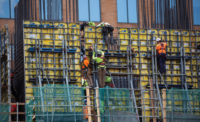Workforce
Ironworkers: Use Pre-Apprenticeships To Boost Industry Diversity

Women, typically underrepresented in the construction industry, could be a valuable new labor pool amid worker shortages.
Photo by yooperann/Flickr
Contractors and unions looking to recruit more women and people of color need to take the first step of reaching out through pre-apprenticeship programs, industry experts told attendees of the North American Ironworkers/IMPACT Conference in San Francisco on Feb. 22.
These efforts are particularly important now, given a shortage of people to work on upcoming projects funded by the Infrastructure Investment and Jobs Act, said Pete Hayes, president of Wisconsin-based contractor Red Cedar Steel Erectors.
“We’re going to try to address the immediate challenge, but it’s also an opportunity to hire from those communities that, typically, construction has basically ignored,” he said. “We want to actively open those doors to have a broader range of people, increase our pool of recruits for our apprenticeship programs and allow more opportunities for workers in these high-paying positions.”
The way that workers learn trades has changed, according to Mike Anderson, business manager at Ironworkers Local 46L in New York City. His local has turned to direct entry programs targeting veterans and people of color, he said, adding that partnerships with high schools and churches have helped find apprentices while also building new connections with contractors, politicians and others in the community.
“When we were younger, there were a lot of trade schools out there,” he said. “Over time, they all disappeared. So, it’s up to us to get out there and show what we can do for their future.”
Pre-apprenticeship programs are particularly beneficial for women, said Ariane Hegewisch, senior research fellow at the Institute for Women’s Policy Research.
“It advertises to women that they are wanted in the Ironworkers,” she said.
Hegewisch added that the Ironworkers’ programs are setting best practices for recruiting women into the industry, giving potential tradeswomen basic skills for the job as well as knowledge of industry jargon and how to deal with any negative comments at a jobsite. After a few weeks of training, the programs place participants into registered apprenticeships. Those programs have helped the industry add nearly 100,000 female workers to construction over the past five years, including many women of color, Hegewisch pointed out.
Some union locals have also turned to prisons for future workers.
Heather Kurtenbach, business agent for Ironworkers Local 86 in Seattle, said she became a tradeswoman after her own incarceration left her unable to find a job. Now she works with the Trades Related Apprentice Coaching program in a Washington State women’s prison. The 16-week pre-apprenticeship offered to infraction-free inmates nearing their release date teaches them building trades skills, as well as money management and soft skills to prepare them for work and life outside prison walls.
Kurtenbach said the program has been so successful for her local that it changed apprenticeship standards so the women don’t need to wait for the next evaluation day, getting them working sooner. That way, she added, the women see they don’t need to return to abusive relationships or other past negative behavior, cutting recidivism.
“They’re good union members,” Kurtenbach said. “They’re involved. They come to meetings. They’re part of our sisters committee, we go out and volunteer in the community.”
For anyone interested in setting up a pre-apprenticeship program targeting women or people of color, but concerned about the costs and effort, there are ways to get help, according to James Owens, training and grants specialist for the Ironworkers union and also a member of Local 86 in Seattle.
The Ironworkers have partnered with community groups to help find people looking for work, and write grants to help cover expenses for intake, instructor wages and administrative costs. Owens said the union has obtained about $3 million in grants and placed more than 270 individuals in apprenticeships in the Pacific Northwest.
Those grants have paid off with an approximately $36-million return-on-investment in the form of workers’ wages and benefits, he emphasized.
The ironworkers have even contracted with the Urban League to handle support services and help find participants, while the union ran training.
“It’s on us as apprenticeships or local unions to reach out and begin that dialogue,” Owens said.
It's also important workers have access to childcare, said Vicki O'Leary, general organizer for the Ironworkers. Female Ironworkers can receive maternity pay for up to six months before giving birth and six-to-eight weeks after with an $800/week cap. Other trades have followed suit, O'Leary said.
But after maternity leave, there are millions of families that rely on daily childcare. Unions and employers need to rethink how they treat workers who may be delayed by needing to drop off a child before work. Plus, center-based childcare costs rose 41% amid the coronavirus pandemic, O'Leary noted, citing a recent analysis from mortgage firm LendingTree. She said those increased costs disproportionately affected working mothers.
"Coronavirus has wreaked havoc for women," she said. "For the most part, it was the women that stayed home and took care of the children, and all of a sudden had to become teachers."




